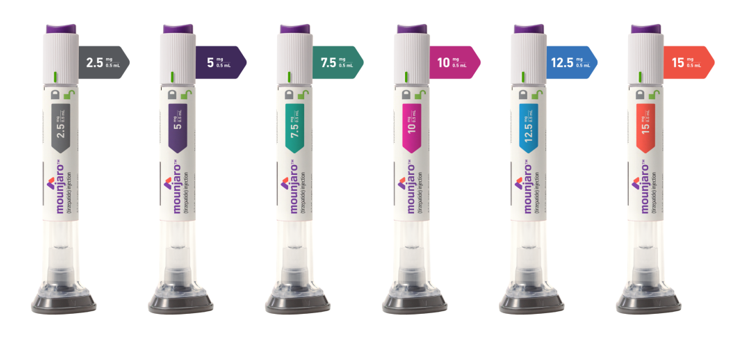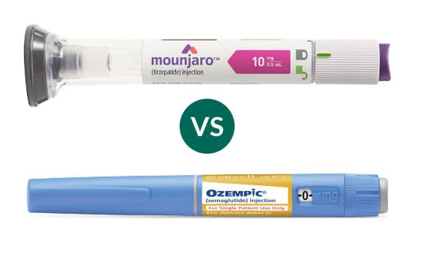Mounjaro 2.5mg, 5mg, 7.5mg, 10mg, 12.5mg, 15mg (0.5mL)

Indication:
Mounjaro is indicated for once-weekly administration as an adjunct to diet and exercise to improve glycemic control for the treatment of adult patients with type 2 diabetes mellitus.
– As monotherapy when metformin is inappropriate due to contraindication or intolerance.
– In combination with:
* metformin, or
* metformin and a sulfonylurea, or
* metformin and a sodium-glucose cotransporter 2 inhibitor (SGLT2i), or
* basal insulin with or without metformin
Method of Administration
Subcutaneous injection once weekly in abdomen, thigh or upper arm.
Side Effects
– Nausea
– Diarrhea
– Vomiting
– Dyspepsia
– Constipation
– Abdominal pain
– Abdominal distension
– Eructation
– Flatulence
– Gastroesophageal reflux disease
– Fatigue
– Injection site reaction
– Weight decreased
– Heart rate increased
– Decreased appetite
Dosing
The recommended starting dose of Mounjaro is 2.5 mg injected subcutaneously once weekly. The 2.5 mg dosage is for treatment initiation and is not intended for glycemic control. After 4 weeks, increase the dose to 5 mg once weekly.
– If additional glycemic control is needed, increase the dosage in 2.5 mg increments after no less than 4 weeks on the current dose
– The maximum dose is 15 mg once weekly
Contraindications
Mounjaro is contraindicated:
– In patients who are hypersensitive to this drug or to any ingredient in the formulation, including any nonmedicinal ingredient, or component of the container
– In patients with a personal or family history of medullary thyroid carcinoma (MTC) or in patients with Multiple Endocrine Neoplasia syndrome type 2 (MEN 2)
– During pregnancy or breast-feeding
Comparison with Ozempic

Both Mounjaro and Ozempic are prescription medicines, used alongside diet and exercise, to help control blood sugar (glucose) levels in adults with type 2 diabetes.
Ozempic is also approved to lower the risk of a major cardiovascular event (like a heart attack, stroke and sudden cardiac death) in patients with type 2 diabetes. Mounjaro has not yet received this indication, although studies are ongoing. But Mounjaro has the potential to positively impact cardiovascular health by addressing key risk factors such as blood pressure, cholesterol levels, and blood sugar control.
Mounjaro and Ozempic are both in the class of drugs known as incretin mimetics but have some differences. Mounjaro acts on both GIP and GLP-1 receptors, while Ozempic acts only on GLP-1 receptors; however, both drugs are effective treatments for type 2 diabetes.
* Mounjaro (tirzepatide), from Eli Lilly, lowers fasting and postprandial glucose concentration, decreases food intake, and reduces body weight in patients with type 2 diabetes mellitus.
* Ozempic (semaglutide), from Novo Nordisk, it slows down how fast food travels through your digestive tract. This can help you feel fuller for longer, reduce how much you eat, and lead to weight loss.
Both Mounjaro and Ozempic are given as weekly injections under the skin (subcutaneously) in the stomach area (abdomen), thigh or upper arm.
Mounjaro was compared to semaglutide (Ozempic) in a 40-week study with over 1,870 participants. Researchers sought to see how these drugs affected A1C reduction. A key secondary endpoint was the amount of weight lost. Neither Mounjaro nor Ozempic are approved for weight loss at this time, but in patients with type 2 diabetes, they may lead to some weight reduction.
Mounjaro 5 mg, 10 mg, and 15 mg injections were compared to semaglutide (Ozempic) 1 mg injections in adults with type 2 diabetes whose blood sugars were not controlled with 1,500 mg/day of metformin alone. Patients in the study had an A1C of 8.3% and a weight of 94.1 kg (207 lb) at the beginning of the study.
* Mounjaro reduced the A1C by 2% to 2.3% compared to a 1.9% reduction for participants in the semaglutide (Ozempic) 1 mg group.
* Mounjaro led to weight loss of 7.7 kg (17 lb) to 11.4 kg (25 lb), on average, compared to 5.9 kg (13 lb) for semaglutide (Ozempic).
* Of note, Ozempic is now approved in a higher 2 mg dose, and effectiveness compared to Mounjaro with this higher dose may vary.
The labeling for both Mounjaro and Ozempic carry Boxed Warnings for possible thyroid tumors, including cancer, which has been seen in animal studies.
Side effects:
Ozempic
– Nausea: 16% to 20%
– Diarrhea: 8.5% to 8.8%
– Vomiting: 5% to 9.2%
– Constipation: 3.1% to 5%
– Heartburn (dyspepsia): 2.7% to 3.5%
– Stomach (abdominal) pain: 5.7% to 7.3%
Mounjaro
– Nausea: 12% to 18%
– Diarrhea: 12% to 17%
– Decreased appetite: 5% to 11%
– Vomiting: 5% to 9%
– Constipation: 6% to 7%
– Heartburn (dyspepsia): 5% to 8%
– Stomach (abdominal) pain: 5% to 6%
Cost comparison
Mounjara’s cost is $300-400 a month. Mounjaro has started to make its way to B.C. pharmacies, but at the moment it is not covered under PharmaCare.
Ozempic’s cost is $200-$300 per month. BC PharmaCare provides coverage for Ozempic as a second-line therapy for Type 2 diabetes to help patients manage blood-sugar levels when metformin is not effective. The cost is not reimbursed for weight loss. Ozempic is listed under special authority for PharmaCare. Criteria includes:
* A minimum 3-month trial of metformin should be considered
* Special Authority coverage of semaglutide is available for up to a maximum dose of 1 mg weekly, in a pen delivery device intended to
give a 1 mg dose. The 2 mg dose is currently under review for reimbursement
* Note: Taking two 0.5 mg doses from a pen delivery device designed to give a 0.5 mg dose is not covered, because the cost is
approximately double the cost of a single 1 mg dose in a 1 mg/dose pen
* Coverage will be provided for either semaglutide or an eligible
dipeptidyl peptidase-4 (DPP-4) inhibitor – not both at the same time
* For patients with Special Authority coverage for a DPP-4 inhibitor, approval for semaglutide coverage will result in discontinuation of
coverage for the DPP-4 inhibitor
